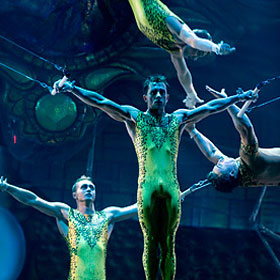Cirque Du Soleil: Zarkana

4/5
Over the last twenty-five years French Canadian outfit Cirque Du Soleil had steadily built itself up from an idiosyncratic acrobatic company to the premier circus troupe in the world, with a back catalogue of two-dozen unique shows, a permanent residency in Las Vegas, others planned in the UAE and Russia, and revenues somewhere in the region of half a billion dollars annually.
Their latest endeavor is Zarkana, the first of a series of planned summer runs at New York City’s storied Radio City Music Hall, showing through the end of October before heading off to Moscow. An art-nouveau inspired fusion of “bizarre” and “arcane,” the show represents something of an evolution for the company in that their trademark tumbling, high-flying acrobatics, and trademark, brash, art design is slotted into the context of a musically propelled narrative, as opposed to the typical, loose trappings of a theme.
Opening with a pulsating instrumental number that sees either side of the grand balcony shaken by dueling church organs we are introduced to the eponymous Zark (French-Canadian pop-star Garou), a magician who has lost his love, and thus his powers. Beseeching the powers that be for her return he traverses a netherworld of strange serpentine creatures.
The foundation of any Cirque performance is it’s grandness, but Radio City as a venue might be a step too far even for them. Many fine musical acts, from Flight of the Conchords to Tori Amos, have found themselves, on occasion, swallowed whole by the venues unforgiving size, and Zarkana is a show that, while it does get big eventually, starts very, very small. Much of what is going on on-stage at any given time is peripheral; filler for the eyes to disguise the fact that the extremely talented young lady juggling a dozen tennis balls with baffling dexterity is in the midst of what would otherwise be a vast empty stage.
These same logistical pitfalls work against other static acts such as the standing gymnasts (although few can fail to gasp in awe at a freestanding, four-person high human tower. AS outstanding as she is unpexted is the sand painter whose gorgeous scrawling is projected onto a jumbotron screen and whose muscle memory defies belief. Indeed, the backing clowns and shadowy, slithering creatures projected onto the enormous backdrop often only serve to distract from the featured act and you wonder how much better advised those behind the idea might have been just to let them stand or fall on their own merit.
It’s not until the flag dancers arrive (so simple, but so elegant) that the show starts to generate a little energy, finally utilizing the available space to its full potential. The sheer physicality of the so-called ‘Wheel of Death’ and the gravity-defying antics of the high-wire team will surely leave audiences agape. And who doesn’t have a soft spot for the shameless schoolyard shtick of the inimitable flagship clowns (warning: audience participation required).
While perfectly adequate in and of themselves, both the underlying narrative (which remains largely incomprehensible) and the pop songs – in English for the first time – are entirely superfluous, and while they do offer a handy diversion for last second on-stage preparation they are neither what audiences will pay to see, nor what they will ultimately remember. As always, what you take away from a Cirque Du Soleil show is a profound sense of wonder over what the human mind-body machine is capable of when this well-drilled and allowed to flourish in an environment of unfettered imagination and creativity.
RELATED ARTICLES
Get the most-revealing celebrity conversations with the uInterview podcast!

![Rockettes Tickets On Sale Now [Dates & Ticket Info]](/blank.gif)



Leave a comment